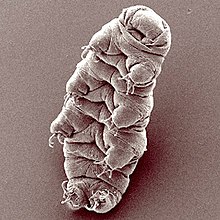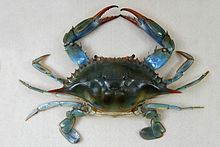Tactopoda
| Tactopoda Temporal range:
| |
|---|---|

| |
| The tardigrade Hypsibius dujardini | |

| |
| The blue crab Callinectes sapidus, an arthropod | |
| Scientific classification | |
| Domain: | Eukaryota |
| Kingdom: | Animalia |
| Subkingdom: | Eumetazoa |
| Clade: | ParaHoxozoa |
| Clade: | Bilateria |
| Clade: | Nephrozoa |
| (unranked): | Protostomia |
| Superphylum: | Ecdysozoa |
| (unranked): | Panarthropoda |
| (unranked): | Tactopoda Budd, 2001 [1] |
Tactopoda or Arthropodoidea is a proposed
below shows the relationships implied by this hypothesis.| Panarthropoda |
| |||||||||||||||
The competing hypothesis is that
Euarthropoda + Onychophora, the arthropods and the velvet worms) is monophyletic,[6]
and tardigrades lie outside this grouping.
| Panarthropoda |
| |||||||||||||||
Anatomic arguments for the tactopoda monophyly include similarities in the anatomies of head, legs, and muscles between the arthropods and the tardigrades. Anatomic arguments against it include that tardigrades lack the kind of circulatory system (including a
phylogenomic evidence in favour of the alternative Euarthropoda+Onychophora grouping.[6]
Etymology
Budd formed the suggested clade name 'tactopoda' from Greek taktos, ordered, and poda, feet, "with reference to the alleged well-formed stepping motion that characterises the group".[1]
Proposed classification
- Phylum Tardigrada
- Class Eutardigrada
- Class Heterotardigrada
- Class Mesotardigrada
- Class
- Phylum Arthropoda
- Class Pycnogonida(?)
- Clade Arachnomorpha
- Class †Trilobita
- Order †Aglaspida
- Order †Strabopida
- Class Pycnogonida(?)
- Order †Cheloniellida
- Subphylum Chelicerata
- Class Xiphosura
- Class †Eurypterida
- Class †Chasmataspidida
- Class Pycnogonida(?)
- Class Arachnida
- Class †
- Clade Mandibulata
- Order †Euthycarcinoidea
- Subphylum Myriapoda
- Clade Pancrustacea
- Clade Oligostraca
- Class Ostracoda
- Class Ichthyostraca
- Class
- Clade Altocrustacea
- Clade Multicrustacea
- Class Hexanauplia
- Class Malacostraca
- Class Thecostraca
- Clade Allotriocarida
- Class Branchiopoda
- Clade Miracrustacea
- Superclass Xenocarida
- Class Cephalocarida
- Class Remipedia
- Subphylum Hexapoda
- Paraphyletic class Entognatha
- Clade Ectognatha
- Class Insecta
- Class
- Superclass Xenocarida
- Clade Multicrustacea
- Clade Oligostraca
- Class
Phylogeny
| Panarthropoda |
| |||||||||||||||||||||||||||||||||||||||||||||||||||||||||||||||||||||||||||||||||
References
- ^ doi:10.1078/0044-5231-00034. Archived from the original(PDF) on 2016-03-03.
- 'S2CID 205239797.
- ^ De Haro, A. (1998). "Origen y relaciones fitogenéticas entre Artrópodos, Onicóforos, Anélidos y Lofoforados, según datos moleculares y morfológicos". Boletín de la Real Sociedad Española de Historia Natural Sección Biológica. 94 (1–2): 103–113.
- PMID 27725256.
- S2CID 7751936.
- ^ PMID 19854297.
